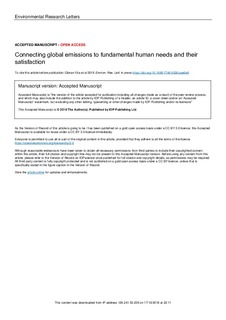Connecting global emissions to fundamental human needs and their satisfaction
Original version
10.1088/1748-9326/aae6e0Abstract
While quality of life (QOL) is the result of satisfying human needs, our current provision strategies result in global environmental degradation. To ensure sustainable QOL, we need to understand the environmental impact of human needs satisfaction. In this paper we deconstruct QOL, and apply the fundamental human needs framework developed by Max-Neef et al to calculate the carbon and energy footprints of subsistence, protection, creation, freedom, leisure, identity, understanding and participation. We find that half of global carbon emissions are driven by subsistence and protection. A similar amount are due to freedom, identity, creation and leisure together, whereas understanding and participation jointly account for less than 4% of global emissions. We use 35 objective and subjective indicators to evaluate human needs satisfaction and their associated carbon footprints across nations. We find that the relationship between QOL and environmental impact is more complex than previously identified through aggregated or single indicators. Satisfying needs such as protection, identity and leisure is generally not correlated with their corresponding footprints. In contrast, the likelihood of satisfying needs for understanding, creation, participation and freedom, increases steeply when moving from low to moderate emissions, and then stagnates. Most objective indicators show a threshold trend with respect to footprints, but most subjective indicators show no relationship, except for freedom and creation. Our study signals the importance of considering both subjective and objective satisfaction to assess QOL-impact relationships at the needs level. In this way, resources could be strategically invested where they strongly relate to social outcomes, and spared where non-consumption satisfiers could be more effective. Through this approach, decoupling human needs satisfaction from environmental damage becomes more attainable.
